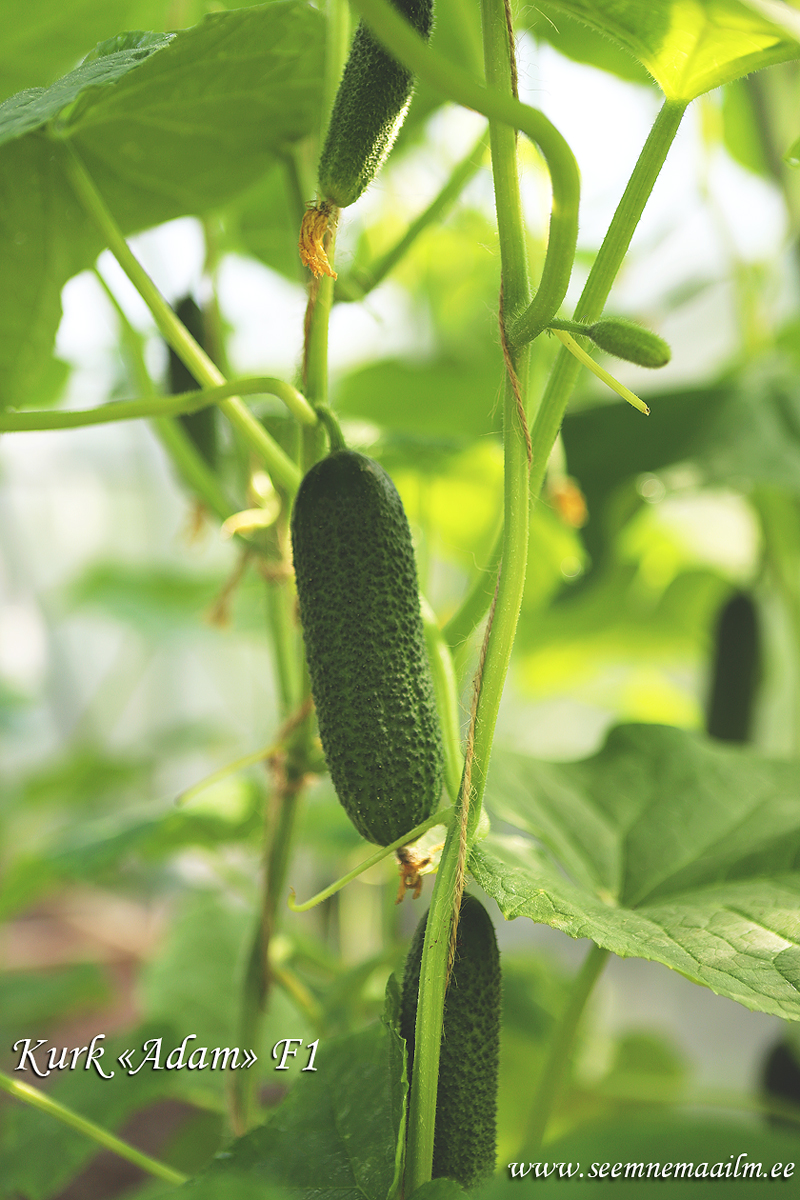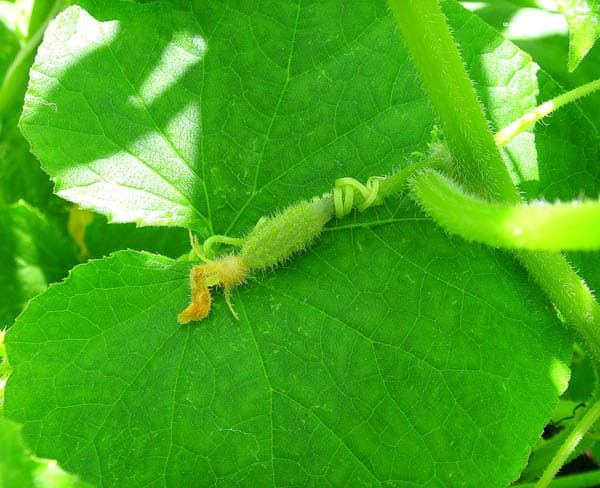One of the best early self-pollinated hybrids (ripens 40-45 days). Bears fruit for a long time due to the yield on the main stem and the formation of a large number of gherkins on the side shoots.
Productive both in the open field and under the film and stands out for its high yield throughout the entire harvesting period, even in adverse conditions.
Fruits are leveled, small tuberous, 7-10 cm, with small seed chambers, crisp, do not form voids and do not taste bitter. Ideal hybrid for canning and fresh consumption. Highly resistant to disease.
Ripening time (from disembarkation of seedlings): 41-52.
Appointment: fresh, salting, pickling.
Disease resistance: Ccu/Px, CMV/CVYV.
Fetal proportions: 3,2:1.
Features and Benefits: ideal for vertical cultivation.



Cucumber. Bot.: Cucumis sativus L.
* Caring for cucumber plantings in the second half of summer.
The cucumber is a very sensitive crop when it comes to growing conditions. It is a heat-loving plant. The roots react most strongly to temperature. The main mass of roots develops at a depth of 10–15 cm. The optimal soil temperature during fruiting is +23–25 °C. Cucumber especially poorly tolerates low soil and air temperatures combined with high humidity. Therefore, in cool weather, watering is best done during the day so that by night the beds dry out a little and the greenhouse can be ventilated.
Some gardeners mistakenly believe that cucumber is a shade-loving plant. It can, of course, tolerate slight shading and still bear fruit.
But the cucumber is a light-loving plant. Shading should be arranged only periodically — at hot noon, when the leaves wilt, to reduce air temperature. The greatest yield of cucumbers occurs during periods of intensive sunlight. If light is insufficient, you can mulch the beds with white film. It reflects light. The film can be of any size; for large sheets, make slits every 20–30 cm for watering and aeration.
Cucumbers do not like drafts, but on hot days intensive ventilation is necessary. Due to weak air movement near the leaf surface, oxygen stagnates and carbon dioxide does not reach the leaf; with high humidity, fruit tip rot may occur. Without ventilation, the plants overheat severely. Overheating negatively affects the intensity of photosynthesis; varieties not genetically free from bitterness develop bitter fruits, especially when combined with under-watering.
Cucumber is demanding of soil and air moisture. Since the roots are located close to the surface, constant watering is necessary.
Systematic lack of moisture causes wilting and yellowing of leaves, the appearance of voids inside the fruit, and deformed fruits with constrictions. With heavy watering in greenhouses, soils often become waterlogged because drainage systems are generally absent. The optimal option is watering in small doses every day, even in cloudy and cool weather.
Cucumber is sensitive to soil compaction; with heavy compaction, plants develop poorly. The optimal ratio of solid, liquid, and gaseous soil phases is 1 : 2 : 3. In the second half of the growing season, the soil becomes compacted. If necessary, loosening should be carried out by making deep fork punctures between the main roots — 2–4 punctures per 1 m². To avoid damaging the roots, most punctures are best made along the base of the beds, where there are fewer roots. The same loosening is performed in case of waterlogging.
When harvesting, keep in mind that fruit size varies greatly depending on the variety. Readiness for harvest is determined by fruit diameter. A cross-section of 3–3.5 cm indicates a fully developed fruit. It may be 7–10 cm to 20–30 cm long. Gherkin-type varieties are harvested small, up to 2.5 cm in diameter. Fruits should not be allowed to overgrow, as oversized fruits accelerate plant aging.
Early harvest removes nutrients from the soil — mainly nitrogen, potassium, and magnesium. Nitrogen accumulates in fruits as nitrates; most of it is in the peel and is used to form leaves and shoots. Potassium salts are also contained in significant amounts in fruits. Magnesium is found in the green parts of the plant. The external signs of nutrient deficiency signal the need for urgent feeding.
Nitrogen deficiency — pale green leaves and whitish tips on the very tops of shoots, fruits with pointed tips.
Potassium deficiency — yellow-green border along the leaf edge.
Magnesium deficiency — small round light-green spots randomly located between the leaf veins, starting on the lower leaves.
Fertilizers should be applied according to instructions, but some general rules must be known.
– Feeding is usually recommended no more than once every 7–10 days.
– Apply fertilizer to moist soil.
– After feeding, quickly water with clean water to wash off any fertilizer that fell on the lower leaves or stems to avoid chemical burns.
– Dissolve fertilizers at a total rate not exceeding 30 g / 10 L, using 10 L of solution per 5 m². A high fertilizer concentration in the soil solution stresses the plant, negatively affects development, and can cause root death or leaf burns.
– Fertilize in warm weather. At low temperatures, feeding efficiency is greatly reduced. Around mid-July, yellowing of lower leaves under favorable conditions is a natural process: nutrients flow to fruits and young shoots. These leaves should not be removed; otherwise, yellowing will intensify. Moreover, as they die, they release carbon dioxide necessary for photosynthesis. Manure and straw decomposing in the soil also serve as carbon dioxide sources.
To keep cucumber plants healthy longer in the second half of summer, it is advisable to clean the plantings: remove dry leaves and cut off fruit-bearing shoots. Ensure good ventilation in the lower layer of the greenhouse. Toward the end of the growing season, old shoots and dry leaves are primarily affected by gray mold, and stagnant humid air in dense vegetation leads to stem and root rot.
Cucumber grows well alongside cruciferous crops, so you can sow Chinese cabbage on well-lit bed edges during summer, or radish in early spring and again closer to autumn.












